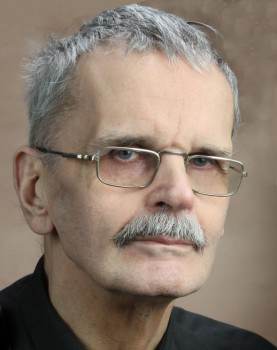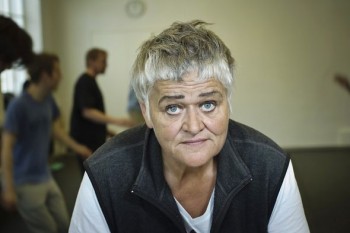Search results for "jarkko/2011/04/matti-suurpaa-parnasso-1951–2011-parnasso-1951–2011"
Sound and meaning
20 January 2012 | Essays, Non-fiction
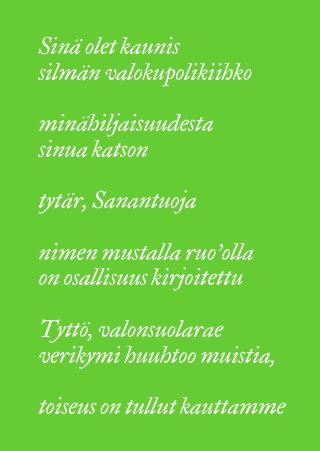
Harri Nordell’s poem from Huuto ja syntyvä puu (‘Scream and tree being born’, 1996)
Translating poetry is natural, claims Tarja Roinila; it is a continuation of writing it, for works of poetry are not finished, self-sufficient products. But is the translator the servant of the meaning – or of the letter?
I am sitting in a cafe in Mexico City, trying to explain in Spanish what valokupolikiihko, ‘light-cupola-ecstasy’, means. And silmän valokupolikiihko, ‘the light-cupola-ecstasy of the eye’.
I take to praising the boundless ability of the Finnish language to form compound words, to weld pieces together without finalising the relationships between them, never mind establishing a hierarchy: the eye is a light-cupola, the eye is ecstatic about light-cupolas, light creates cupolas, the cupola lets out the light, the eye, in its ecstasy, creates a light-cupola. More…
Jari Tervo: Layla
28 October 2011 | Mini reviews, Reviews
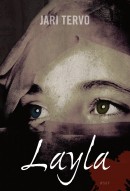 Layla
Layla
Helsinki: WSOY, 2011. 361 p.
ISBN 978-951-0-38277-6
31 €, hardback
Social reality has stepped firmly into contemporary Finnish literature. Many of the new novels deal with economic inequality, immigration, prostitution or human trafficking. In his 13th novel Jari Tervo (born 1959) deals with them all. Layla is a young Kurdish girl whose cruel fate is about to be decided by the men of her family in Turkey. When she flees, Layla ends up in faraway Finland as a prostitute. Another storyline portrays a Finnish woman, Helena, who sells herself in part voluntarily. Tervo shows himself to be a feminist; the men he describes are cold tyrants who see a woman’s body as an object of lust and as merchandise. The novel is tragic and defiant, but also amusing and lively. Tervo’s style involves surprises and ingenious tricks, of which towards the end of the book there are slightly too many. Layla contains a good deal of information about Turkey, Kurdish culture and the people smuggling that takes place on the outer borders of the European Union. Some of the details have already been shown to be inaccurate, but this does not reduce the distressing quality of this story of a human fate.
Translated by David McDuff
Funny peculiar
9 December 2011 | Articles, Comics, Non-fiction
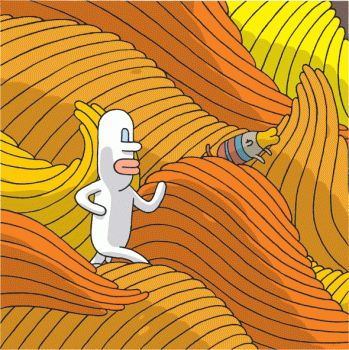
Samuel, the creation of Tommi Musturi (featured in Books from Finland on 7 May, 2010, entitled ‘Song without words’)
Comics? The Finnish word for them, sarjakuva, means, literally, ‘serial picture’, and lacks any connotation with the ‘comic’. The genre, which now also encompasses works called graphic novels, has been the subject of celebrations this year in Finland, where it has reached its hundredth birthday. Heikki Jokinen takes a look at this modern art form
Comics are an art form that combines image and word and functions according to its own grammatical rules. It has two mother tongues: word and image. Both of them carry the story in their own way. Images and sequences of images have been used since ancient times to tell stories, and stories, for their part, are the common language of humanity. The long dark nights of the stone age were no doubt enlivened by storytellers.
One of the pioneers of comics was the Swiss artist Rodolphe Töpffer. As early as 1837, he explained how his books, combinations of images and words, should be read: ‘This little booklet is complex by nature. It is made up of a series of my own line drawings, each accompanied by a couple of lines of text. Without text, the meaning of the drawings would remain obscure; without drawings, the text would remain without content. The whole gives birth to a sort of novel – but one which is in fact no more reminiscent of a novel than of any other work.’ More…
Johanna Ilmakunnas: Kapiot, kartanot, rykmentit. Erään aatelissuvun elämäntapa 1700-luvun Ruotsissa [Trousseaus, manors, regiments. The lifestyle of one noble house in 18th-century Sweden]
28 July 2011 | Mini reviews, Reviews
 Kapiot, kartanot, rykmentit. Erään aatelissuvun elämäntapa 1700-luvun Ruotsissa
Kapiot, kartanot, rykmentit. Erään aatelissuvun elämäntapa 1700-luvun Ruotsissa
[Trousseaus, manors, regiments. The lifestyle of one noble house in 18th-century Sweden]
Helsinki: Suomalaisen Kirjallisuuden Seura, 2011. 524 p., ill.
ISBN 978-952-222-264-0
€ 38, hardback
This book deals with the lifestyles, finances and consumption habits of the high nobility of Sweden in the 18th century (which included Finland at that time). The central figure is Count Axel von Fersen (1719–1794), a very influential statesman and soldier, and his German-Baltic lineage. This portrait broadens into a lifestyle study, providing extensive information on the customs and the world of the nobility of that era, such as the institution of marriage, child-rearing, mistresses, clothing and interior decor – as indicators of one’s social status – artistic activities, games and gastronomy. The topic of consumption is linked to social, cultural, ideological and legal perspectives. In the lives of the high nobility, money – or lack thereof – was not a defining feature; rather, choices were governed by ideals, values and obligations such as honour, reputation, faith and origin. Johanna Ilmakunnas is a historical researcher and editor. This book is based on her award-winning doctoral thesis (2009).
Translated by Ruth Urbom
Allan Tiitta: Sinisten maisemien mies. J.G. Granön tutkijantie 1882–1956 [The man of blue landscapes. A biography of J.G. Granö, 1882–1956]
9 February 2012 | Mini reviews, Reviews
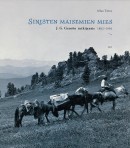 Sinisten maisemien mies. J.G. Granön tutkijantie 1882–1956
Sinisten maisemien mies. J.G. Granön tutkijantie 1882–1956
[The man of blue landscapes. A biography of J.G. Granö, 1882–1956]
Kuvatomittaja [Picture editor]: Taneli Eskola
Helsinki: Finnish Literature Society, 2011. 541 p., ill.
ISBN 978-952-222-292-3
€ 44, hardback
The man of blue landscapes describes the life and work of the Finnish geographer Johannes Gabriel Granö (1882–1956), whose career also reflected Finland’s development as a modern state. Granö was a scientific explorer, writer, a pioneer of Finnish photographic art and a professor of geography at the universities of Tartu (Estonia), Helsinki and Turku. In Estonia he applied scientific method to the study of local history and from Tartu brought the tradition of urban research. Granö spent much of his youth in Omsk in western Siberia, where his father worked as a priest among displaced and deported Finns and Estonians. From 1906 to 1916 Granö made an expedition to Mongolia and the Altai mountains, but his fieldwork remained unfinished when the 1917 revolution broke out; the area was then closed to Western scholars for 70 years. Among Granö’s most important works are the classic travel book Altai, vaellusvuosina nähtyä ja elettyä (‘The Altai, seen and experienced during my years of travel’, 1921) and his methodological masterpiece Puhdas maantiede (‘Pure geography’, 1930). In it Granö outlined a theory of landscapes, and the book was a pioneering work ahead of its time: landscape was examined in terms of the relation between human beings and their environment, as the sum of all the senses.
Translated by David McDuff
Hannele Huovi & Kristiina Louhi: Jättityttö ja Pirhonen [The giant girl and Mr Pirhonen]
17 January 2012 | Mini reviews, Reviews
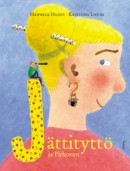 Jättityttö ja Pirhonen
Jättityttö ja Pirhonen
[The giant girl and Mr Pirhonen]
Kuvitus [Ill. by]: Kristiina Louhi
Helsinki: Tammi, 2011. 31 p.
ISBN 978-951-31-5852-1
€ 19.95, hardback
Hannele Huovi and Kristiina Louhi, two eminent professionals in the field of children’s literature, have been collaborating for a long time. Their mutual trust is reflected in the way they grant each other artistic freedom, at times submitting to the text, at others to the illustrations. The depiction of the love story between a giant girl and a tiny man was an exceptional challenge for the illustrator; Tyyne’s tears nearly drown her tiny friend, and to see him properly, she needs a magnifying glass! Louhi has again kept her style economical, and she boldly paints large expanses of colour and forms. Alongside the unequal but happy love story, this picture book deals with tolerance. Tyyne’s enormous size effectively manifests her feeling that she is an outsider. The book also advocates a relaxed attitude to life and the avoidance of unnecessary strain. The example of the giant girl helps the reader to develop a sense of proportion and to realise the value of the everyday.
Translated by Fleur Jeremiah and Emily Jeremiah
Tuomas Heikkilä & Liisa Suvikumpu: Suomen Turku julistaa joulurauhan. Åbo kungör julfred [Finland’s Turku announces the Christmas peace]
9 December 2011 | Mini reviews, Reviews
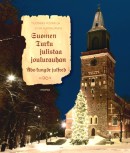 Suomen Turku julistaa joulurauhan. Åbo kungör julfred
Suomen Turku julistaa joulurauhan. Åbo kungör julfred
[Finland’s Turku announces the Christmas peace]
Swedish translation: Malena Torvalds-Westerlund
Helsinki: Kirjapaja, 2011. 71 p., ill.
ISBN 978-952-247-229-8
€ 24, hardback
This bilingual book offers a broad interpretation of a unique Christmas tradition upheld by the Finns: at 12 on Christmas Eve a large proportion of the population falls silent to listen to the declaration of the Christmas peace from Turku cathedral. After its bells have rung noon, the deputy mayor ceremonially opens a manuscript prepared according to mediaeval tradition and reads the announcement in both Finnish and Swedish. After the announcement, the land settles down to celebrate Christmas following traditions dating from the 13th century. The Christmas peace has been announced in Turku almost without interruption since the Middle Ages. The last time it went unread was in 1939, during the Winter War. The Finnish Broadcasting Company broadcasts the occasion to all the member countries of the European Broadcasting Union EBU. The Christmas peace is also sent out into the world by Swedish radio, reaching a total of some 140 countries.
Translated by Hildi Hawkins
Vesa Puuronen: Rasistinen Suomi [Racist Finland]
6 July 2011 | Mini reviews, Reviews
 Rasistinen Suomi
Rasistinen Suomi
[Racist Finland]
Helsinki: Gaudeamus, 2011. 286 p., ill.
ISBN 978-952-495-196-8
€ 36, paperback
Multiculturalism, immigration and racism have become more frequent subjects of discussion in Finland, particularly as a result of the 2008 local elections and the subsequent speeches and writings by people critical of immigration. This book aims to move the discussion forward by describing and defining racism, presenting developments in research into racism, racism perpetrated by Finns against Sámi and Russians, and the history of Finnish enmity towards Russians from the early 20th century to the present day. The author considers the use of shaming and subjugation as tools of exterminating Sámi culture, as well as linguistic discrimination and denial of land ownership rights against the Sámi. The book also examines the development of hate crimes since the 1990s, racism in Finnish politics and the politics of multiculturalism as practised in Finland, which studies have shown treat different minority groups in different ways. Vesa Puuronen is a sociologist and a researcher into racism who works at the University of Eastern Finland.
Translated by Ruth Urbom
Taken by surprise
In her fifth collection of poems, Pauliina Haasjoki explores night flights, water, islands, sandy beaches where time is found stratified in stones and fossils. Interview by Teemu Manninen
Poems from Aallonmurtaja (‘Breakwater’, Otava, 2011)
Night flight
Man cannot hide in the night, his desire will betray him.
Man turns toward the lights, light sparkles as though it were close at hand
even if it is far away.
Lights, which offer themselves like jewels to the one who sits in the plane above them, are already
in their viewers’
eyes even if they have only just begun to stream from their source. A city-jewel swaying
in the black night air.
A solitary light on the surface of an island. Seen close up it is a soft-lit lamp
which casts light only on the table and the faces around it,
but from above, at a distance of kilometres, it is an immediate spot, a straight line that
aims at the viewer
and pierces her. A fierce light-beam.
Finlandia Prize for Non-Fiction 2012
5 December 2012 | In the news
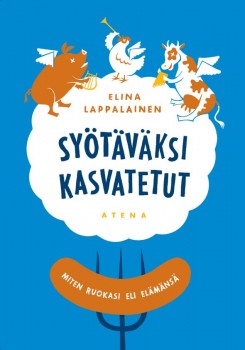 ‘It is one of the rules of quality journalism that writers aim for even-handed and impartial reporting, but at the same time challenge their respondents to account for their actions. Writers should also have the capacity for in-depth reporting and analysis,’ said Janne Virkkunen, former Editor-in-Chief of Helsingin Sanomat newspaper on 8 November, as he announced the winner of this year’s Finlandia Prize for Non-Fiction, worth €30,000.
‘It is one of the rules of quality journalism that writers aim for even-handed and impartial reporting, but at the same time challenge their respondents to account for their actions. Writers should also have the capacity for in-depth reporting and analysis,’ said Janne Virkkunen, former Editor-in-Chief of Helsingin Sanomat newspaper on 8 November, as he announced the winner of this year’s Finlandia Prize for Non-Fiction, worth €30,000.
The winner, Syötäväksi kasvatetut. Miten ruokasi eli elämänsä (‘Grown to be eaten. How your food lived its life’, Atena) by the young journalist Elina Lappalainen, is her first book.
‘The book could have fallen prey to the sensationalism of which we all probably have experience in the media, at least. This writer was able to avoid the temptation,’ Janne Virkkunen said.
The other works on the shortlist of six were as follows: Arabikevät (‘The Arab spring’, Avain), a study of spring 2011 in the Arab world by Lilly Korpiola and Hanna Nikkanen, Norsusta nautilukseen. Löytöretkiä eläinkuvituksen historiaan (‘From the elephant to the nautilus. Explorations into the illustration of animals’, John Nurminen Foundation) by Anto Leikola, Kevyt kosketus venäjän kieleen (‘A light touch to the Russian language’, Gaudeamus) by professor of Russian Arto Mustajoki, Karhun kainalossa. Suomen kylmä sota 1947–1990 (‘Under the arm of the Bear. Finland’s Cold War 1947–1990’, Otava) by Jukka Tarkka and Markkinat ja demokratia. Loppu enemmistön tyrannialle (‘Market and democracy. The end of the tyranny of the majority’, Otava) by banker Björn Wahlroos.
Tuuve Aro: Korson purppuraruusu [The purple rose of Korso]
16 January 2012 | Mini reviews, Reviews
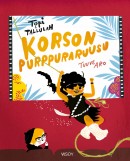 Korson purppuraruusu
Korson purppuraruusu
[The purple rose of Korso]
Kuvitus [Ill. by]: Sanna Mander
Helsinki: WSOY, 2011. 109 p.
ISBN 978-951-0-38052-9
€ 25.70, hardback
Sometimes a book’s appearance is enough to win the reader over. The first children’s novel by writer and film critic Tuuve Aro (born 1973) encourages the belief that things will work out for the best. The book’s positive undertones are also reflected in Mander’s fresh illustrations, which exude retro-nostalgia for the 1950s and 1960s in shades of orange, black, and brown. Tallulah, a jungle princess, turns up unexpectedly to sort out the complicated affairs of Topi, a schoolboy who is being bullied. Tallulah comes into the suburb of Korso from the silver screen, out of Woody Allen’s film The Purple Rose of Cairo. The jungle princess helps Topi to see the bleak suburb as an exotic habitat where adventures are waiting just round the corner. The adult reader gets to enjoy a few carefully chosen references to major cinematic landmarks. Aro eschews problem-centred realism and angst, even though the children’s problems are an indirect result of decisions taken by adults. The Tallulah figure incorporates a hefty dose of anarchy, familiar from Astrid Lindgren’s Pippi Longstocking.
Translated by Fleur Jeremiah and Emily Jeremiah
Tiia Aarnipuu: Jonkun on uskallettava katsoa. Animalian puoli vuosisataa [Someone’s got to dare to look. Half a century of Animalia]
28 July 2011 | Mini reviews, Reviews
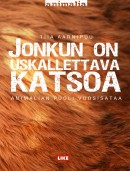 Jonkun on uskallettava katsoa. Animalian puoli vuosisataa
Jonkun on uskallettava katsoa. Animalian puoli vuosisataa
[Someone’s got to dare to look. Half a century of Animalia]
Helsinki: Like Kustannus, 2011. 209 p., ill.
ISBN 978-952-01-0582-2
€ 33, paperback
This book has been published to mark the 50th anniversary of Animalia, the Federation for the Protection of Animals. The public image of the organisation has varied between one of a conservative club of ladies and gentlemen and that of a radical terrorist group. Animalia was founded in 1961, inspired by Johan Börtz, a Swede who gave lectures on the plight of animals used in experiments. Animalia began making visits to inspect animal testing facilities, which were completely unregulated in the early 1960s. Gradually the animal rights movement became more radicalised, somewhat later than in places such as Britain. Animal rights became a subject of wider debate in Finland in the 1980s. In the 1990s, the organisation was falsely linked with attacks made on fur farms by direct-action youth groups. Animalia’s stance has been to renounce vandalism and violence. In February 2010 Animalia launched its largest-ever information campaign, aimed at ridding Finland of fur farms by 2025.
Translated by Ruth Urbom
Leena Krohn: Auringon lapsia [Children of the sun]
16 January 2012 | Mini reviews, Reviews
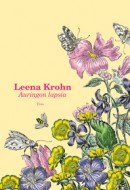 Auringon lapsia
Auringon lapsia
[Children of the sun]
Kuvitus [Ill. by]: Inari Krohn
Helsinki: Teos, 2011. 32 p.
ISBN 978-951-851-311-0
€ 29.40, hardback
It is great news that Leena Krohn has not abandoned the young readership she first addressed through her first book Vihreä vallankumous (‘The green revolution’, 1970), an ecocritical title that also touched on active citizenship. This novel, too, is about the encounter between man and nature. Ten-year-old Orvokki (Violet) is a delivery girl for a florist; like her, the reader is incited to marvel with naive curiosity at life’s various wonders. Krohn is supremely good at writing literature that knows no age limits. Nothing here will go over a child’s head; the essence of the book is accessible to all. In this nicely old-fashioned children’s novel the measured language and expression are pleasing both to the eye and the ear. The hand-coloured graphic prints by the artist (and writer’s sister) Inari Krohn are a homage to Maria Sibylla Merian (1647–1717), the German natural scientist and illustrator who produced life-like paintings of insects and plants.
Translated by Fleur Jeremiah and Emily Jeremiah

